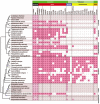Reconstructing the evolutionary history of the centriole from protein components
- PMID: 20388734
- PMCID: PMC2858018
- DOI: 10.1242/jcs.064873
Reconstructing the evolutionary history of the centriole from protein components
Abstract
Centrioles are highly conserved structures that fulfil important cellular functions, such as nucleation of cilia and flagella (basal-body function) and organisation of pericentriolar material to form the centrosome. The evolution of these functions can be inferred from the distribution of the molecular components of extant centrioles and centrosomes. Here, we undertake an evolutionary analysis of 53 proteins known either for centriolar association or for involvement in cilia-associated pathologies. By linking protein distribution in 45 diverse eukaryotes with organism biology, we provide molecular evidence to show that basal-body function is ancestral, whereas the presence of the centrosome is specific to the Holozoa. We define an ancestral centriolar inventory of 14 core proteins, Polo-like-kinase, and proteins associated with Bardet-Biedl syndrome (BBS) and Meckel-Gruber syndrome. We show that the BBSome is absent from organisms that produce cilia only for motility, predicting a dominant and ancient role for this complex in sensory function. We also show that the unusual centriole of Caenorhabditis elegans is highly divergent in both protein composition and sequence. Finally, we demonstrate a correlation between the presence of specific centriolar proteins and eye evolution. This correlation is used to predict proteins with functions in the development of ciliary, but not rhabdomeric, eyes.
Figures


References
-
- Altschul S. F., Gish W., Miller W., Myers E. W., Lipman D. J. (1990). Basic local alignment search tool. J. Mol. Biol. 215, 403-410 - PubMed
-
- Arendt D. (2003). Evolution of eyes and photoreceptor cell types. Int. J. Dev. Biol. 47, 563-571 - PubMed
-
- Arendt D., Tessmar-Raible K., Snyman H., Dorresteijn A. W., Wittbrodt J. (2004). Ciliary photoreceptors with a vertebrate-type opsin in an invertebrate brain. Science 306, 869-871 - PubMed
-
- Badano J. L., Mitsuma N., Beales P. L., Katsanis N. (2006). The ciliopathies: an emerging class of human genetic disorders. Annu. Rev. Genomics Hum. Genet. 7, 125-148 - PubMed
Publication types
MeSH terms
Substances
Grants and funding
LinkOut - more resources
Full Text Sources

